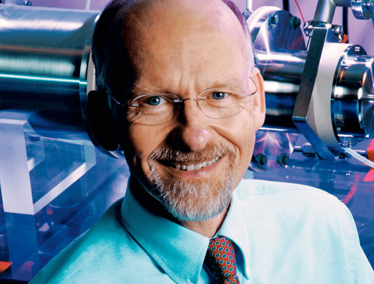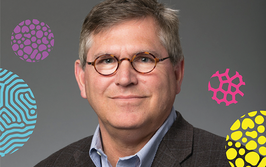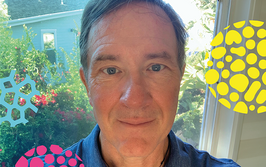The Distinguished Scientist
Richard D. Smith, Chief Scientist of the Biological Sciences Division at Pacific Northwest National Laboratory, reflects on 40 years in mass spectrometry following his Distinguished Contribution award at ASMS 2013.

How does it make you feel to be recognized as making a “distinguished contribution to mass spectrometry”?
The field of mass spectrometry (MS) has grown greatly in importance in recent years, particularly for biological applications where MS is the ‘go to’ tool for many key -omics measurements – proteomics, metabolomics, lipidomics, glycomics. They are what I refer to as ‘pan-omics’. I feel honored and humbled to be recognized as contributing to this endeavor, and also recognize that really this award extends to the fantastic set of colleagues, past and present, at PNNL.
How did you find your way into your career?
It goes back to the mid-1970s – very early in my career – when I was thinking about what large research impacts might be enabled by MS. At that time, there was a very small community pursuing the development of MS for what are now considered extremely simple biological applications. Applying MS for the characterization of whole ‘biological systems’ was really not discussed; the possibilities then were greatly constrained by some really difficult problems: lack of sensitivity, limitations of MS ionization methods, separation methods to which MS could be interfaced, and a range of other MS capabilities. I was intrigued by these problems, and realized that if they could be solved, MS could become an integral technique for biological research.
My career has centered on addressing these MS technology issues and applying the improved techniques in as broad a context as possible. It’s fun to be part of a much larger research agenda and contribute to areas that can affect all of us in one way or another, for example, in cancer-related research or improving biofuel production. Importantly, our applied work also provides continuous feedback on which technical issues are limiting – presenting a better focus for our technology development efforts.
As an example, one of the most common limitations encountered in using MS for biological applications is its sensitivity; very often the available sample size is really small, which means the total amount of material available for characterization can be miniscule. Technology developments that significantly improve sensitivity can make the difference between success and failure for a given application. Every improvement made in MS sensitivity opens up a wider range of applications. These applications now extend all the way to the level of a single cell. At present, I believe the major limitations for single cell measurements are not MS sensitivity, but rather the capabilities to ‘select’ cells, to properly manipulate the resulting tiny sample, and provide the throughput and reliability to make these measurements something that can be broadly applied.
When you conceived of the electrodynamic ion funnel, what impact did you think it would have?
My initial thinking was that it would address the sensitivity issue for the use of electrospray ionization with MS – and to a large extent that has turned out to be correct. Our fundamental understanding of electrospray ionization indicates that it can be a nearly perfect ion source in terms of ionization efficiency, but a key limitation has been in getting the ions into the MS analyzer. The ion funnel has largely solved this issue. And in a related fashion the ion funnel also has had other impacts, in particular, making the combination of ion mobility with MS much more effective.
“"What we really need is to take MS-based proteomics, metabolomics, lipidomics and related measurements, and be able to make them not just ten times faster but a million times faster."”
What is the most exciting development in MS technology that you have seen in the last five years?
There have been many, but advances in the sensitivity and resolving power of ion mobility separations in conjunction with MS are at the top of my list. The ability to add a fast stage of separation, and to do this in an essentially lossless fashion is a huge advance. Such advances not only help to better deal with biological complexity, but also provide additional information (for example, protein-shape-related mobility data), and actually also increase the dynamic range of the measurements and the sensitivity achievable. I suspect that ion mobility separations will become an increasingly common component of MS instruments.
You are described as having an "obsession for sensitivity" – what drives this obsession and where is it likely to lead you next?
Actually, I think of myself as having a ‘passion for sensitivity’, but the difference between passion and obsession is in the eye of the beholder… More seriously, what drives this is the desire to better characterize, and ultimately understand, biological systems. And this gets to what I really want to focus on next. If you look at what we really need to effectively apply systems biology approaches, it will require much, much more data across the pan-omics data types (for example, proteomics). However, the throughput of present measurements (that is to say, the rate at which we can make measurements and fully analyze samples) lags by many orders of magnitude behind what can now be done in genomics. What we really need is to take MS-based proteomics, metabolomics, lipidomics and related measurements, and be able to make them not just ten times faster but a million times faster.
The direction I spend more and more time thinking about involves completely new paradigms in which we can manipulate and separate ions in highly parallel, lossless, and complex ways, and then analyze them in massively parallel MS systems. And while the key pieces are already beginning to coalesce, there are still significant challenges for doing this, not least being how to deal with the enormous flood of data that these new platforms will produce. But staggering advances in computation are continuing and this community is learning quickly from dealing with the advances in genomics, so there are lots of reasons for optimism.

Rich Whitworth completed his studies in medical biochemistry at the University of Leicester, UK, in 1998. To cut a long story short, he escaped to Tokyo to spend five years working for the largest English language publisher in Japan. "Carving out a career in the megalopolis that is Tokyo changed my outlook forever. When seeing life through such a kaleidoscopic lens, it's hard not to get truly caught up in the moment." On returning to the UK, after a few false starts with grey, corporate publishers, Rich was snapped up by Texere Publishing, where he spearheaded the editorial development of The Analytical Scientist. "I feel honored to be part of the close-knit team that forged The Analytical Scientist – we've created a very fresh and forward-thinking publication." Rich is now also Content Director of Texere Publishing, the company behind The Analytical Scientist.

















